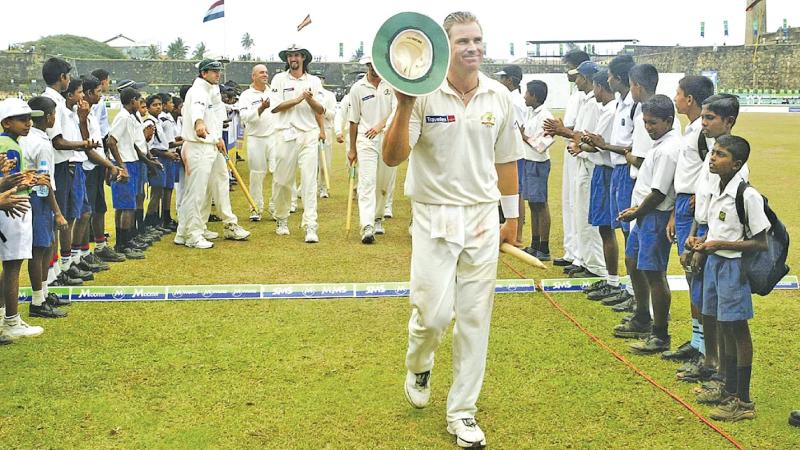
The shock death of ex-Australian bowler Shane Warne brings back memories how he cut his teeth at the infamous 1992 SSC Test, became the most hated down the years until the 2004 Asian tsunami devastated the island
It was noon time at the Sinhalese Sports Club (SSC) in Colombo on September 22, 1992 and five reporters (unlike a hundred today) covering the first Test between Australia and Sri Lanka rushed out of the Press Box to grab a snack for lunch on a cloudy day.
 Never before did Press guys get that over-the-moon excitement that Sri Lanka was to win a Test match against Australia with a 181 target and two full sessions of play left and the match then snowballing to 127 for 2 at one stage and victory within touching distance.
Never before did Press guys get that over-the-moon excitement that Sri Lanka was to win a Test match against Australia with a 181 target and two full sessions of play left and the match then snowballing to 127 for 2 at one stage and victory within touching distance.
But lo and behold came what was to be the start of the making of a global superstar by the name of Shane Warne, a shy behind-the-scene bowler that Arjuna Ranatunga and Romesh Kaluwitharana, then making his debut, smashed for 107 runs in the first innings as he went wicket-less while playing in his first overseas Test with only a scalp tucked in his waist.
Then came the most tantalizing of all moments in a dramatic Test match that Sri Lankans had never before witnessed as Australian skipper Alan Border with not much under his belt lobbed the ball to Warne with Sri Lanka now needing 31 runs to win and three wickets in hand and the soundly set Asanka Gurusinha threatening to finish off the contest in his own swashbuckling style.
Warne plucked the last three wickets of Pramodya Wickremasinghe, Don Anurasiri and Ranjith Madurasinghe that left the maestro Gurusinha watching in disbelief at the non-striker’s end, stranded on 31 and Sri Lanka all out for 164 with Australia winning by 16 runs while snatching victory from the jaws of defeat.
At a time when reporters had to work harder for their stories with no rules laid down for media protocols like today, the five Pressmen that included a local correspondent working for the AFP international news agency wasted no time to rush to the Australian dressing room.
 What they heard and saw was the entire Australian team playing and singing their famous victory song “Under the Southern Cross” and it marked the first time that the Sri Lankan media had a hang of what life was like in the Aussie dressing room.
What they heard and saw was the entire Australian team playing and singing their famous victory song “Under the Southern Cross” and it marked the first time that the Sri Lankan media had a hang of what life was like in the Aussie dressing room.
Warne was to admit it was three terrifying moments that shaped his career. “If it was shown live on Aussie TV it would be remembered as one of the greatest Test matches of all time,” Warne declared.
A year later in 1993 Warne bowled what was branded the “ball of the century” when he shifted the off bail of England’s Mike Gatting in an Ashes Test with a ball that cut in from outside the leg-stump.
But down the road Warne became probably the most hated Australian by Sri Lankans and was even at the receiving end of scorn from none other than foreign Minister Lakshman Kadiragamar who branded the him a “sissy” when the Australians refused to play their 1996 qualifying round World Cup match in Colombo citing security fears in the aftermath of a deadly and devastating bombing of the central bank.
“While shopping (in Colombo) I can be in the wrong place at the wrong time,” Warne said when asked why they declined to tour Sri Lanka. “Shopping is for sissies”, Minister Kadiragamar hit back at a heavily packed news conference at his Ministry office.
But it took the lives of nearly 30,000 people and an island in ruins for Sri Lankans to rally around Warne in a way they have never loved a foreigner when the Asian tsunami of 2004 struck the coast line.
 Warne was the first high profile foreigner to see the devastation especially at the Galle cricket stadium that was rebuilt thanks to funds raised through his iconic image.
Warne was the first high profile foreigner to see the devastation especially at the Galle cricket stadium that was rebuilt thanks to funds raised through his iconic image.
Hundreds of schoolboys lined up after they pleaded with their masters to allow them to greet the man that changed the course the way Sri Lankans looked at Australians.
A young boy waiting patiently told Warne: “We want you to hold the record for the most number of wickets, not Muralidaran,” as emotions ran high that day.
But it was hard to figure out who was the happier of the two on that day.
Warne ended his career with 708 scalps and Muralidaran with 800 with the Sri Lankan bowler’s last wicket taken on the very ground that the Australian helped to rebuild.
